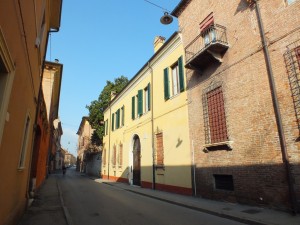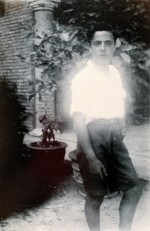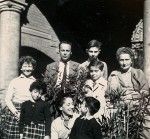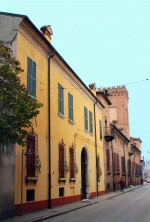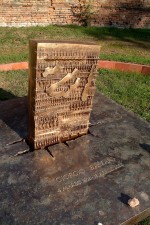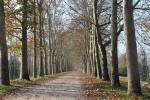Casa Bassani
PROVA
The Building
In this ancient noble residence on the central Via Cisterna del Follo, Giorgio Bassani spent his childhood and adolescence with his father Enrico Bassani, mother Dora Minerbi, and younger siblings Paolo and Jenny. He left in May 1943 when he was arrested for his anti-fascist activities. After his release on July 26, he went into hiding, first in Florence and then in Rome. The family, who remained in Ferrara, survived the German roundups hidden in a closet, but many relatives were deported to Buchenwald. They joined him in Florence and returned to Ferrara after the war. The magnolia tree mentioned in the poem 'Le leggi razziali' from the collection 'Epitaffio' still towers over the garden's inner wall. In 2009, the Municipality of Ferrara placed a plaque on the two-story residential building's facade that reads: 'In this dearly loved house, Giorgio Bassani, 1916-2000, opened himself to poetry and high civic commitment.
Combining reality and fantasy, a description of the building is offered Giorgio Bassani himself through a conversation had between two characters (the narrator and his friend Pulga) in his novel Behind the Door (Dietro la Porta). However, in the story, the house is located in Via Scandiana, a road that, not by chance, runs parallel to Via Cisterna del Follo. The presence of the mother figure, for whom the writer had a particularly deep, profound sense of affection, is quite notable in the scenes that take place in the house in Via Cisterna del Follo. However, Bassani only wrote directly and openly of that relationship in ‘Frammenti di Vita’, a tribute to his childhood, his love for his mother, and a rendering of the trauma caused by the sudden appearance of his father (who returned on leave from the battlefront). Not included in Romanzo di Ferrara, it was published posthumously [G. Bassani, ‘Frammenti di una Vita’, in Bassani. Racconti, Diari, Cronache (1935-1956), Ed. by P. Pieri, Feltrinelli, Milan 2014, p. 89s.]
The Magnolia Tree
Any description of the childhood home of Giorgio Bassani must mention the large magnolia tree in the courtyard. Still visible behind the wall, it is quite impressive in and of itself. But it is also imbued with symbolic meaning and even celebrated in one of Bassani’s most famous poems: Le Leggi Razziali (Racial Laws).
However, it isn’t the only element in the garden, which was also inhabited, in real life as in the imaginary-literary version, by a pet turtle, remembered in Behind the Door.
Quotes
"In those swift flashes, in those half-visions, we, as children, had constructed our lives. The tall walls of the garden were something more than ordinary walls. They represented defined barriers, brutal in the mocking laughter of shiny shards on the edges but also profoundly ideal. On this side was the common and sensible world; beyond it, the mystery, survival, and fairy tale. [...] It was more in those glances thrown from the highest windows of the house, from the boldest dormers down to catch a secret, that we lived with all our souls; the closest things, already as if they were ours, that we knew out there, just beyond the wall - the hoarse street organ and its gentle blind owner that we imagined, never having seen them, as a single bent person or, at least, two individuals cruelly bound together, voice and body, soul and flesh; the barely whispered words of the people passing by; the four beggars, above all, wrapped in black cloaks, always motionless – those were the creatures of our nightmare, the sustenance of the continuous daydream." (Giorgio Bassani, I mendicanti, in Bassani. Stories, Diaries, Chronicles (1935-1956), 2014, pp. 54-55).
‘My father left for the war, and my mother, who had no reason to live alone, with me being just a few months old, in the rented flat in Bologna, so she decided to return to Ferrara. For a few months she lived with her widower father-in-law, my grandfather Davide, in the house in Via Cisterna del Follo. And although I wasn’t born there, I did spend my entire childhood, adolescence and youth there.’
G. Bassani, La Capra, in Bassani. Racconti, Diari, Cronache (1935-1956), Ed. by P. Pieri, Feltrinelli, Milan 2014, p. 352]
“We had almost arrived. We left Via Madama by Piazza Santa Maria in Vado and turned down Via Scandiana. ‘What was that kind of barrier down there at the end of the street?’ Pulga asked me, as we went on walking. And with his raised arm he pointed to the mist-blurred prow of the Montagnone, against which Via Scandiana seemed to come to an end.
I stopped in front of the entrance to my house, pressed the bell, and turned round to explain to him what the Montagnone was. But he was already distracted by something else.
‘Good heavens!’ he exclaimed in a serious tone. ‘It’s a mansion!’
He stepped back to the centre of the street, keeping his gaze upwards.
‘Is it all yours?’
‘Yes.’
‘It must have heaps of rooms.’
‘Quite a few...Including the first and second floor, there must be something like fifty.’
‘And they’re all taken just by your family?’
‘Oh no. ‘We live only in those on the second floor. There are tenants on the first floor.’
‘So, you and your family live in twenty or so rooms?’
‘More or less.’
‘How many of you are there?’
‘There are five of us. My father, my mother and us three children: that is me, my brother, Ernesto, and my sister, Fanny. Then you’d have to count the maids...
‘Twenty rooms! Imagine the cost to heat them. And the tenants?’
At that moment, the latch of the door sprang open. I raised my eyes. My mother was at the window.”
(G. Bassani, ‘Dietro la Porta’, Opere, Il Romanzo di Ferrara, Mondadori 2001, p.613s.)
Le Leggi Razziali (Racial Laws)
The Magnolia that stands in the middle
of the garden of our home in Ferrara
is exactly the one that appears
in almost all my books.
We planted it in ‘39
a few months after the issuing
of the racial laws with the ceremony
that was in part solemn and in part comical
all of them rather festive God
willing
in spite of our boring meta-historical
Judaism
Constrained by four rather close
impassable walls, it grew
black luminous invasive
stretching resolutely towards the imminent
sky
in the light of day and ashen night
blackbird-brown sparrows
stared at tirelessly from below
by pregnant cats and even
my mother
also she an untiring observer from behind
the windowsill e’er overflowing
with her crumbs
Straight as a sword from base to top
it now peeks out over the surrounding roofs it now can see
every part of the city and the infinite
greenery that surrounds it
but now it is uncertain I know
I see it
all at once stretching up there at the pinnacle at once weak
in the sun
like one who suddenly hasn’t arrived
having reached the end of a long journey
which street to take what
to do
(G. Bassani, ‘In Rima e Senza’, in Opere, Mondadori 2001, p.1438 s.)
‘It was very hot in my room. As soon as I entered, I locked the door and went to open the window. It was a beautiful starry night, without a moon but very clear. Down in the garden, the shapes of the trees stood out clearly: there was the magnolia, further on the spruce, and down below, in the opposite corner, where the three arches of the entry portico ended, the linden tree. Between flowerbed and flowerbed, the milky white of the gravel, and in the middle of the open space, even lighter as it opened out in front of the dark cavity of the portico, was a motionless black spot. Perhaps a stone, or maybe Filomena, the hundred-year-old turtle of the house that, as mother had joyously mentioned at dinner, had come out of hibernation.’
(G. Bassani, ‘Dietro la Porta’, Opere, Il Romanzo di Ferrara, Mondadori 2001, p.651)
Bibliography
- Giorgio Bassani, Dietro la porta in Opere, Il romanzo di Ferrara, Mondadori 2001
- Giorgio Bassani, Le leggi razziali in Opere, In rima e senza, Mondadori 2001
- Luciano Chiappini, Gli Estensi. Mille anni di storia, Corbo, Ferrara 2001
- Melchiorri, Gerolamo, Bassi, Carlo, Nomenclatura ed etimologia delle piazze e strade di Ferrara. Ampliamenti all'opera di Gerolamo Melchiorri, 2G, Ferrara 2009
- Pieri, Piero (a cura di), Bassani. Racconti, diari, cronache. 1935-1956, Feltrinelli, Milano 2014
- Bassani, Giorgio, I mendicanti, in Pieri, Piero (a cura di), Bassani. Racconti, diari, cronache. 1935-1956, Feltrinelli, Milano 2014, pp. 53-57
Sitography
- fondazionegiorgiobassani.it
- resistenzamappe.it/ferrara-fe_persecuzioni-casa_bassani.all
- www.ferraraterraeacqua.it/it/scopri-il-territorio/itinerari-e-visite/itinerari-storici-culturali/ferrara-dautore-i-luoghi-di-giorgio-bassani
- https://www.youtube.com/watch?v=y83XDzoL1CQ
Fototeca
Related places
Related Subjects
Related Itineraries
Compiling entity
- Istituto di Storia Contemporanea di Ferrara
- Assessorato alla Cultura e al Turismo, Comune di Ferrara
Author
- Federica Pezzoli
- Sharon Reichel
- Barbara Pizzo

